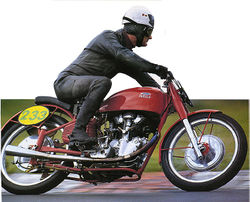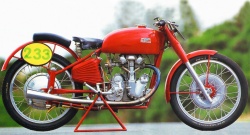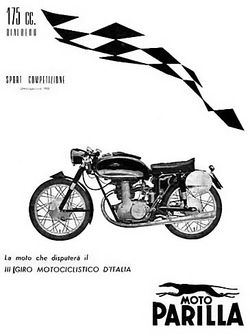Parilla
1946 - 1967
Giovanni Parrilla (that is the correct spelling of his name before they dropped one "R" to make it easier to pronounce) was born in Southern Italy in 1912. Giovanni opened his first business near Milan, Italy in which he worked on diesel injection pumps and was a Bosch spark plug wholesaler. After WWII in October 1946, Giovanni released two newly designed racing motorcycles (first new Italian racing design since the end of the war).
Giovanni was not actually the designer of this newly released prototype, but his employee Guiseppe Salmaggi was. Guiseppe under the instruction of Giovanni developed a motorcycle patterned after the British Norton with a single vertical cylinder and bevel-driven camshaft. Giovanni thought that an Italian produced British style motorcycle would sell better on the Italian market.

Both prototype motorcycles were 246.32 cc (66 X 72 mm) single cylinder engines with gear driven camshafts. The compression ratio of both engines was kept at a "Low" 6:1 due to the fact that fuel was not only hard to obtain, but what you could get was of very low quality. Due to the fuel problems, and the low compression, these engines only produced approximately 15 bhp @ 6200 rpm.
The frames for these prototypes were fully-welded, loop-style frames with single front downtubes. The plunger rear suspension with adjustable friction dampers soon gave way to the more modern swing-arm. Front suspension was girder style front forks which also were also later changed to leading-axle telescopics.
In 1947 production of the Corsa (racer) and the Sportster street bike began, and popularity of the Parilla line of motorcycles started to boom. The Corsa was later nicknamed padellone (which means large frying pan) due to its massive 260 mm (10.25 inches worth) brake drums both front and rear. By this time, the horsepower had been upped to approximately 18, which would propel these bikes upwards of 92 mph (about seven more mph over the original prototypes).
Also in 1947 a new design was being worked on, in which there would be a double-cam version called the Bialbero. This bike was released in 1948, and with the new design and a slightly higher compression ratio (7:8:1), the horsepower was now up to 21 which would also increase the speeds up to just over 100 mph. Alloys were used as much as possible to reduce the weight of the previous version (the Bialbero came in right at 250 lbs).
In 1950 the 250 cc engine was joined by a 350 cc version, and both versions were shipped to Hermann Gablenz and Roland Schell of Germany, who used these motorcycles to dominate the German racing scene. During this time "Schell" worked with the Parilla factory, and the release of a newly designed "Six speed gear box" occurred.
In late 1952, Giovanni Parrilla decided that the design of the engines needed to be re-worked, and first Camme Rialzata (high-cam) was produced. This new design was released in a 175 cc version called the Fox Roadster. A 125 cc chain-driven dohc appeared at Monza for the 1952 Italian GP the same year, however it never was entered, and its production ended right there. Different versions were produced and tested over the next few years.
By late 1953 and into 1954, a new over-the-counter production racer was released called the 175 cc Competizione, which was later upgraded into the 175 cc MSDS. Later both 200 cc and 250 cc versions of this motorcycle were built exclusively for the North American market.
By the late 1950's and into the mid 1960's, the American racing scene was dominated by the Parilla motorcycle, and hardly a race would go by without somebody saying that the Parilla was the motorcycle to beat. Strangely enough most of the races that were being won, were being done on stock Parilla motorcycles with over-the-counter parts.
In 1962, Giovanni Parrilla sold his motorcycle company to a holding firm, which eventually went belly-up due to a recession in Italy in 1967, when the doors were closed for good.
You ask what ever happened to Giovanni Parrilla, well he and his sons switched to a line of go-kart engines, which was very successful. Source
Gallery
Parilla Founo with a 98 cc 4 stroke engine Source
Parilla 49cc 2 stroke 2 speed Source
1948 Parilla 49 cc 4 stroke 3 speed engine Source
1949 Parilla Fauno 98cc 4 stroke 4 speed engine Source
External Links
| Motorcycle Information and Photos by Marque: A - B - C - D - E - F - G - H - I - J - K - L - M - N - O - P - Q - R - S - T - U - V - W - X - Y - Z |
| Car Information and Photos by Marque: A - B - C - D - E - F - G - H - I - J - K - L - M - N - O - P - Q - R - S - T - U - V - W - X - Y - Z |






















